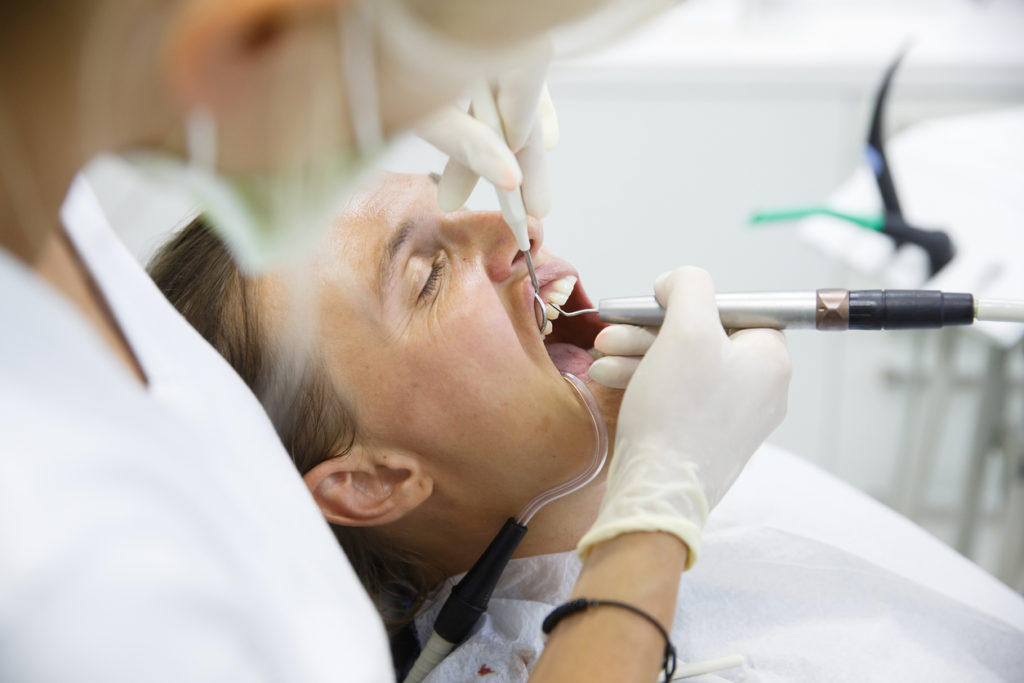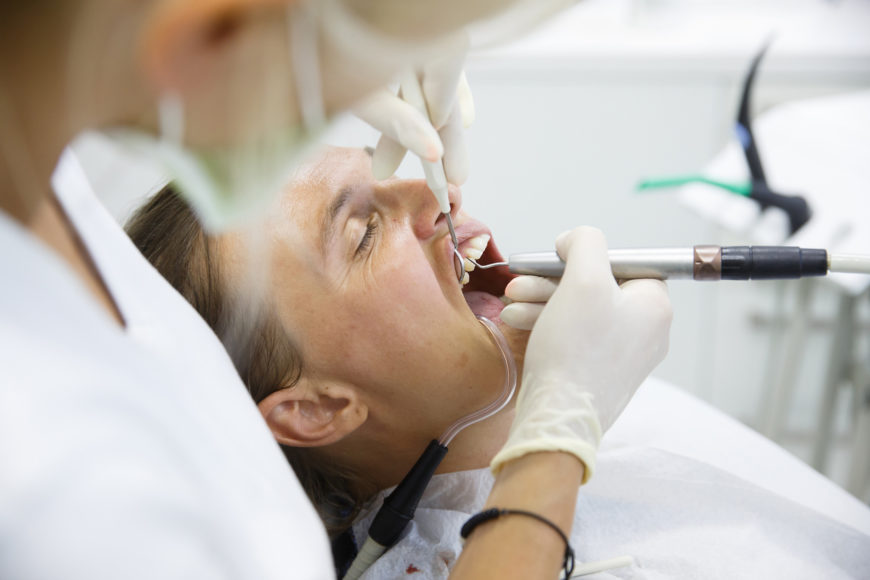
Dr. Gerson placed great importance on dental health for Gerson patients. He said: “The restoration of the teeth is an absolute requirement for the treatment, to prevent infection and toxic disturbances from defects of the teeth and inflamed gums.”
There appears to be a connection between root canals and the incidence of degenerative disease. Remarkably, there have been reports of individuals having root canals removed and then healing from their current condition. Weston A. Price, DDS, conducted original research on the effects of root canals; in his first experiment, he extracted the root canal tooth from an arthritic wheelchair-bound woman and she was able to walk without a cane almost immediately. Gerson patients have also reported positive effects from removing their root canal teeth.
Tooth Structure
Teeth are composted of soft tissue pulp surrounded by a hard layer of dentin and then covered by white surface enamel. The pulp contains nerves, connective tissue and blood vessels, which promote root growth during tooth development and continue to provide nutrients to the dentin. The roots of a tooth extend into the jawbone where they are held in place by the periodontal ligament. The roots contain part of the pulp.
What is a Root Canal Treatment?
 Endodontic treatment, commonly referred to as a root canal, is deemed necessary when the pulp becomes inflamed or infected. Typically, infection of the pulp us caused by decay (such as an untreated cavity), multiple dental procedures done on the tooth, a cracked or chipped tooth, faulty crowns, or trauma to the tooth. If the infection is left untreated, inflammation will result. This will cause pain or abscess.
Endodontic treatment, commonly referred to as a root canal, is deemed necessary when the pulp becomes inflamed or infected. Typically, infection of the pulp us caused by decay (such as an untreated cavity), multiple dental procedures done on the tooth, a cracked or chipped tooth, faulty crowns, or trauma to the tooth. If the infection is left untreated, inflammation will result. This will cause pain or abscess.
A root canal procedure is quite intensive. A dentist or endodontist removes the inflamed or infected pulp, carefully cleans the inside of the tooth, disinfects it and then fills and seals the tooth with gutta-percha. Gutta-percha is a rubber-like material which is heated and compressed to fill the root canal cavity. After the treatment, the tooth is capped with a crown or filling for protection. The tooth will appear to function normally; however there are some complications. It is impossible to remove all of the infected, dead tissue from the canal of the tooth or to completely sterilize the area. Antibiotics used to treat the infection rarely make it to the infected area and the substances used to cleanse and seal the tooth are cytotoxic and sometimes carcinogenic.
While a root canal is a routine procedure that involves little to no discomfort, regular check-ups are still needed because a tooth without its nerve remains able to develop cavities or gum disease.4
Root Canals and Disease
Weston A. Price, Hal Huggins, George Meinig and other holistic dentists who researched root-canaled teeth discovered that they can house anaerobic (able to survive without oxygen) bacteria that may cause serious medical conditions, such as heart disease, kidney disease, neurological diseases (such as ALS and MS) and autoimmune diseases (such as lupus). Some of these conditions may not appear until years, or even decades later, making it difficult to trace the origin of the disease.2
In addition to large roots, there are miles of microscopic tubules (canals) inside the dentin of teeth which can’t be filled and sealed off during a root canal. Bacteria hide out in these tubules. Deprived of oxygen and food, they continue living, but in a more toxic form. These bacteria can infect the tooth, periodontal ligament or jawbone, even while often causing few or no symptoms. When a person chews, some of the toxins from the bacteria and dead tissue in the tubules leak into the blood stream.2
A strong immune system can capture and destroy these bacteria, but when the immune system is weakened by illness the bacteria can migrate throughout the human body and infect the heart, kidneys, joints, nervous system, eyes and brain.5
There are a number of influential doctors and dentists who have studied root canals and made substantial arguments against having the procedure, including:
- Weston A. Price, DDS conducted dental research for 25 years, published 220 articles and wrote Dental Infections & Oral Systemic and Dental Infections and the Degenerative Diseases. He found streptococcus, staphylococcus, spirochetes and fungi in root canal-treated teeth.5
- Hal Huggins, DDS did extensive research on amalgam fillings and used DNA technology to identify multiple pathological bacteria in root canal teeth, such as staphylococcus aureus.
- Josef Issels MD, a retired German oncologist who noticed a correlation between root canals and cancer incidence. He reported that 97 percent of his cancer patients had root canals.
- Thomas Rau, MD is head of the Paracelsus Cancer clinic in Switzerland. In 2004, he found that 98.5 percent of his breast cancer patients admitted for treatment had root canals on the same meridian as the original breast tumor. (In traditional Chinese medicine, a meridian is a path through which life-energy flows).
- Robert Kulacz, DDS published the book The Roots of Disease: Connecting Dentistry and Medicine, which describes many cases of people whose health has been restored by removing root canals.
- Dawn Ewing, ND, Executive Director of the International Academy of Biological Dentistry and Medicine (IAOMT) has assembled educational materials on root canals and how to find a holistic dentist.
- George Meinig, DDS, past president of the American Association of Endodontists made Dr. Price’s discoveries available to the public and medical professionals by writing the book Root Canal Cover-Up, lecturing and appearing on television shows.
What if I need a root canal or have one?
You may be able to avoid the need for a root canal through good nutrition, a healthful lifestyle and practicing preventative care. If it is not possible to save a tooth, you may want to consider extracting the tooth instead of having a root canal. Some holistic dentists report good results doing root canals using calcium oxide as a tooth-filler. If you already have a root canal, removal of the tooth may be advised even for those in good health; however, if you have a serious or chronic illness, removal may be critical for your recovery.
Gerson Patients
Because Gerson patients are often seriously ill, Gerson doctors strongly advice them not to undergo root canal procedure, and if they already have root canals, to get them removed. Gerson patients should always discuss root canal extraction and its timing with their Gerson practitioner. Gerson doctors have found that patients in good condition can immediately extract root canaled teeth, while patients in a weakened condition may need to start the therapy and them remove the root canaled teeth when they are stronger and showing signs of improvement.
Extraction Method
To resolve root canal issues, it is best to work with a holistic or biological dentist (a dentist who uses non-toxic diagnostic and therapeutic approaches) who is trained in proper root canal extraction methods and use of the safest biocompatible materials. These dentists often use a procedure called “cavitation surgery”. A cavitation is “a cavity within the bone which was formerly occupied by a tooth…that is lined with dead bone.” Cavitations can form as a result of root canals, tooth extractions or impacted wisdom teeth and often contain bacteria. Cavitation surgery removes the diseased bone and thoroughly cleans out the cavitation site. In order to prevent infections resulting from tooth extraction, some holistic dentists recommend removing the tooth, then removing the periodontal ligament with a slow moving drill, and removing about 1 mm of the bony socket. Dr. Meinig also outlines a specific protocol for removing root canal teeth in his book, Root Canal Cover-up.10
There are several options for replacing an extracted tooth, including implants, a partial plate and a fixed bridge. Biological dentists can help you find the best and most compatible materials for your body.
To find a biological dentist in your area, contact the organizations below:
- International Academy of Biological Dentistry and Medicine (IABDM) – iabdm.org
- Holistic Dental Network – holisticdental.org
- International Academy of Oral Medicine and Toxicology – iaomt.org
- Consumers for Dental Choice – toxicteeth.org
Sources
1Gerson, Max. MD. A Cancer Therapy: Results of Fifty Cases. New York: Whittier Books, 1958.62. Print.
2Mercola, J., DO. (2012 February, 18). 97% of Terminal Cancer Patients Previously Had Root Canal Procedure. Retrieved February 26, 2015 from Dr. Mercola’s website: http://articles.mercola.com/sites/articles/archive/2012/02/18/dangers-of-root-canaled-teeth.aspx
3Root Canals. (2014). Retrieved February 26, 2015 from American Association of Endodontists’ website: http://www.aae.org/patients/treatments-and-procedures/root-canals/root-canals.aspx
4Root Canals. (2014). Retrieved February 26, 2015 from American Dental Association’s website: http://www.mouthhealthy.org/en/az-topics/r/root-canals
5Meinig, George E., DDS, FACD. Root Canals Pose Health Threat. Retrieved February 27, 2015 from Healing Teeth Naturally’s website: http://www.healingteethnaturally.com/summary-weston-price-root-canal-research.html
6Wagner, C. (2013). Root Canals and Cancer. Retrieved February 26, 2015, from Center for Advancement in Cancer Education’s website: http://beatcancer.org/2014/03/root-canals-and-cancer/
7Huggins Applied Healing. (n.d.). Root Canals Contain Toxic Bacterium. Retrieved February 26, 2015, from http://www.hugginsappliedhealing.com/root-canals-toxic.php
8Koral, Stephen M. Calcium (2011), Oxide Root Fillings (Endocal-10, Biocalex): Three Year Follow-Up. The Open Dentistry Journal, 2011,5, 13-17.
9Williams, L. (January 21, 2012). Dental Caviation Surgery – Appropriate Pre-and Post-Extraction Protocols When Surgical Intervention is Necessary. Retrieved February 26, 2015 from the Weston A. Price Foundation’s website: http://www.westonaprice.org/holistic-healthcare/dental-cavitation-surgery/
10Laura Lee Interview with George Meinig, DDS & Dr. M. LaMarche. (n.d.). Retrieved February 26, 2015 from http://www.tldp.com/issue/157-8/157rootc.htm
11Vizcarra, C., DDS. Incidence Levels and Chronic Health Effects Related to Cavitations. (n.d.). Retrieved February 26, 2015 from Corrine Vizcarra DDS website: http://www.biodentistrydrvizcarra.com/?s=8&sub=8
12Meinig, George E., DDS, FACD. Root Canal Cover-Up. California. Price-Pottenger Nutrition Foundation, 2008. Print.
This article originally appeared in the Spring 2015 issue of Healing News.
Written by: Taylor Oliver | Taylor Oliver is a patient follow-up specialist, co-author of the Gerson Therapy Cookbook and Assistant Chef at the Gerson Institute. Taylor is also part of the core research team for a current 40-year Melanoma Study (in partnership with the Gerson Research Organization).
Post by: Nicole Ferrer
Join our Email List and
Follow Along on Facebook, Instagram and Twitter
![]() Educational articles like this are made possible with the help of your donations. Help us continue the legacy of Dr. Max Gerson, his daughter Charlotte Gerson, and the thousands who rely on the Gerson Institute for vital educational materials and training.
Educational articles like this are made possible with the help of your donations. Help us continue the legacy of Dr. Max Gerson, his daughter Charlotte Gerson, and the thousands who rely on the Gerson Institute for vital educational materials and training.


